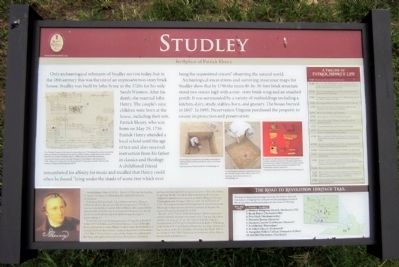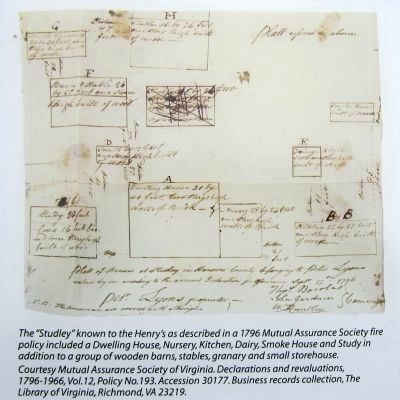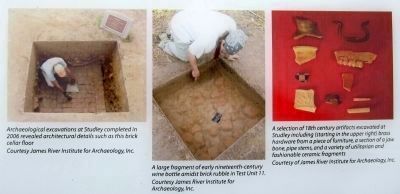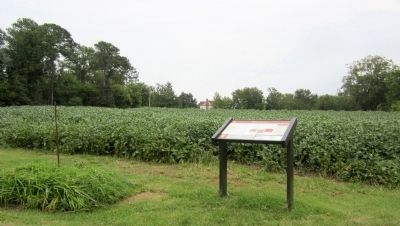Studley in Hanover County, Virginia — The American South (Mid-Atlantic)
Studley
Birthplace of Patrick Henry
Archeological excavations and surviving insurance maps for Studley show that by 1796 the main 40-by-30-foot brick structure stood two stories high with a one-story brick wing and an attached porch. It was surrounded by a variety of outbuildings including a kitchen, dairy, study, stables, barn, and granary. The house burned in 1807. In 1995, Preservation Virginia purchased the property to ensure its protection and preservation.
(sidebar)
Patrick Henry (May 29, 1736 – June 6, 1799) was the leading Virginia statesman in defending the rights of Colonial America.
Following Henrys death, John Adams wrote to Thomas Jefferson singing his praises: “In the Congress of 1774 there was not one member, except Patrick Henry, who appeared to me sensible of the Precipice or rather the Pinnacle on which he stood, and had the candour and courage enough to acknowledge it.”
Henry was the first elected governor of Virginia, a devoted father of 17 children, and the most famous orator of his day. Born in Hanover County, Henry made a name for himself as a young lawyer in the Parsons’ Cause at Hanover Courthouse in 1763. His 1765 resolutions against the Stamp Act articulated the basic principles of the American Revolution. Henry is perhaps best known for his immortal words “Give me liberty or give me death,” which he delivered during the Second Virginia Convention in a speech to fellow delegates George Washington and Thomas Jefferson at St. John’s Church in 1775. His impassioned words helped move colonists toward American independence and they continue to inspire the cause of freedom around the world.
Known as the “Voice of the Revolution,” Henry’s political career included 26 years of service in the Virginia legislature and five terms as governor. He helped draft the Virginia Constitution of 1776 and its Declaration of Rights. A leading critic of the U.S. Constitution, Henry also strongly influenced the creation of the Bill of Rights. Following his death, Henry was buried at
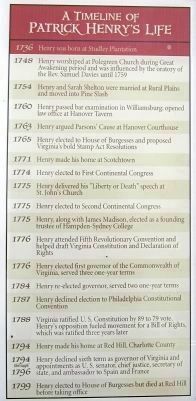
2. A Timeline of Patrick Henry’s Life
1736 Henry was born at Studley Plantation
1748 Henry worshiped at Polegreen Church during Great Awakening period and was influenced by the oratory of the Rev. Samuel Davies until 1759
1754 Henry and Sarah Shelton were married at Rural Plains and moved into Pine Slash
1760 Henry passed bar examination in Williamsburg; opened law office at Hanover Tavern
1763 Henry argued Parsons’ Cause at Hanover Courthouse
1765 Henry elected to House of Burgesses and proposed Virginia’s bold Stamp Act Resolutions
1771 Henry made his home at Scotchtown
1774 Henry elected to First Continental Congress
1775 Henry delivered his “Liberty or Death” speech at St. Johns Church
1775 Henry elected to Second Continental Congress
1775 Henry, along with James Madison, elected as a founding trustee of Hampden-Sydney College
1776 Henry attended Fifth Revolutionary Convention and helped draft Virginia Constitution and Declaration of Rights
1776 Henry elected first governor of the Commonwealth of Virginia, served three one-year terms
1784 Henry re-elected governor, served two one-year terms
1787 Henry declined election to Philadelphia Constitutional Convention
1788 Virginia ratified U.S. Constitution by 89 to 79 vote, Henry’s opposition fueled movement for a Bill of Rights, which was ratified three years later
1794 Henry made his home at Red Hill, Charlotte County
1794 through 1796 Henry declined sixth term as governor of Virginia and appointments as U.S. senator, chief justice, secretary of state, and ambassador to Spain and France
1799 Henry elected to House of Burgesses but died at Red Hill before taking office
1748 Henry worshiped at Polegreen Church during Great Awakening period and was influenced by the oratory of the Rev. Samuel Davies until 1759
1754 Henry and Sarah Shelton were married at Rural Plains and moved into Pine Slash
1760 Henry passed bar examination in Williamsburg; opened law office at Hanover Tavern
1763 Henry argued Parsons’ Cause at Hanover Courthouse
1765 Henry elected to House of Burgesses and proposed Virginia’s bold Stamp Act Resolutions
1771 Henry made his home at Scotchtown
1774 Henry elected to First Continental Congress
1775 Henry delivered his “Liberty or Death” speech at St. Johns Church
1775 Henry elected to Second Continental Congress
1775 Henry, along with James Madison, elected as a founding trustee of Hampden-Sydney College
1776 Henry attended Fifth Revolutionary Convention and helped draft Virginia Constitution and Declaration of Rights
1776 Henry elected first governor of the Commonwealth of Virginia, served three one-year terms
1784 Henry re-elected governor, served two one-year terms
1787 Henry declined election to Philadelphia Constitutional Convention
1788 Virginia ratified U.S. Constitution by 89 to 79 vote, Henry’s opposition fueled movement for a Bill of Rights, which was ratified three years later
1794 Henry made his home at Red Hill, Charlotte County
1794 through 1796 Henry declined sixth term as governor of Virginia and appointments as U.S. senator, chief justice, secretary of state, and ambassador to Spain and France
1799 Henry elected to House of Burgesses but died at Red Hill before taking office
Erected 2011 by The Road to Revolution Heritage Trail. (Marker Number 1.)
Topics and series. This historical marker is listed in these topic lists: Colonial Era • Patriots & Patriotism. In addition, it is included in the Former U.S. Presidents: #02 John Adams, and the Former U.S. Presidents: #03 Thomas Jefferson series lists. A significant historical month for this entry is May 1985.
Location. 37° 40.146′ N, 77° 17.467′ W. Marker is in Studley, Virginia, in Hanover County. Marker is on Studley Farms Drive (Virginia Route 700) 0.4 miles south of Studley Road (Virginia Route 606), on the left when traveling south. Touch for map. Marker is in this post office area: Mechanicsville VA 23116, United States of America. Touch for directions.
Other nearby markers. At least 8 other markers are within 2 miles of this marker, measured as the crow flies. Studley Cemetery (here, next to this marker); Salem Church/Haw’s Shop (approx. half a mile away); Early Airmail Service (approx. half a mile away); Patrick Henry's Birthplace (approx. half a mile away); a different marker also named Studley (approx. half a mile away); Unknown Confederate Soldiers (approx. 1.2 miles away); Enon Church (approx. 1.2 miles away); a different marker also named Enon Church (approx. 1.2 miles away). Touch for a list and map of all markers in Studley.
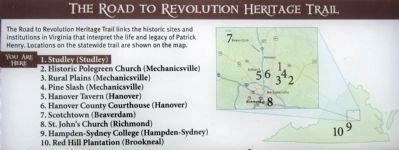
3. Road to Revolution Heritage Trail
The Road to Revolution Heritage Trail links the historic sites and institutions in Virginia that interpret the life and legacy of Patrick Henry. Locations on the statewide trail are shown on the map.
1. Studley (Studley)
2. Historic Polegreen Church (Mechanicsville)
3. Rural Plains (Mechanicsville)
4. Pine Slash (Mechanicsville)
5. Hanover Tavern (Hanover)
6. Hanover County Courthouse (Hanover)
7. Scotchtown (Beaverdam)
8. St. John’s Church (Richmond)
9. Hampden-Sydney College (Hampden-Sydney)
10. Red Hill Plantation (Brookneal)
1. Studley (Studley)
2. Historic Polegreen Church (Mechanicsville)
3. Rural Plains (Mechanicsville)
4. Pine Slash (Mechanicsville)
5. Hanover Tavern (Hanover)
6. Hanover County Courthouse (Hanover)
7. Scotchtown (Beaverdam)
8. St. John’s Church (Richmond)
9. Hampden-Sydney College (Hampden-Sydney)
10. Red Hill Plantation (Brookneal)
More about this marker. On the left is an image of "The “Studley” known to the Henry’s as described in a 1796 Mutual Assurance Society fire policy included a Dwelling House, Nursery, Kitchen, Dairy, Smoke House and Study in addition to a group of wooden barns, stables, granary and small storehouse. Courtesy Mutual Assurance Society of Virginia. Declarations and revaluations, 1796-1966, Vol. 12, Policy No. 193. Accession 30177. Business records collection, The Library of Virginia, Richmond, VA 23219."
On the lower right are photos of the "Archaeological excavations at Studley completed in 2006 revealed architectural details such as this brick cellar floor", and "A large fragment of early nineteenth-century wine bottle amidst brick rubble in Test Unit 11." Also, "A selection of 18th century artifacts excavated at Studley including (starting in the upper right) brass hardware from a piece of furniture, a section of a jaw bone, pipe stems, and a variety of utilitarian and fashionable ceramic fragments" Courtesy of James River Institute for Archaeology, Inc.
Also see . . .
1. The Road to Revolution Heritage Trail. (Submitted on September 2, 2011.)
2. Patirck Henry (1736-1799). Encyclopedia Virginia Virginia Foundation for the Humanities (Submitted on September 2, 2011.)
Credits. This page was last revised on September 14, 2023. It was originally submitted on September 2, 2011, by Bernard Fisher of Richmond, Virginia. This page has been viewed 2,527 times since then and 185 times this year. Photos: 1, 2, 3, 4, 5, 6. submitted on September 2, 2011, by Bernard Fisher of Richmond, Virginia.
